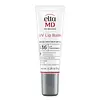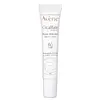What's inside
What's inside
 Key Ingredients
Key Ingredients

 Benefits
Benefits

 Concerns
Concerns

 Ingredients Side-by-side
Ingredients Side-by-side

Ethylhexyl Methoxycinnamate 7.5%
UV AbsorberZinc Oxide 7%
Cosmetic ColorantPetrolatum
EmollientRicinus Communis Seed Oil
MaskingCetearyl Alcohol
EmollientWater
Skin ConditioningLauryl Laurate
Skin ConditioningAroma
Polyethylene
AbrasiveOlea Europaea Fruit Oil
MaskingHydrogenated Soybean Oil
EmollientBeeswax
Emulsion StabilisingGlycerin
HumectantGlyceryl Behenate
EmollientCopernicia Cerifera Wax
Euphorbia Cerifera Wax
Hydrogenated Castor Oil
EmollientHydrolyzed Caesalpinia Spinosa Gum
AbsorbentMicrocrystalline Wax
Emulsion StabilisingCaesalpinia Spinosa Gum
Skin ConditioningSodium Benzoate
MaskingPotassium Sorbate
PreservativeAscorbyl Palmitate
AntioxidantThioctic Acid
AntioxidantTocopheryl Acetate
AntioxidantQuercetin
AntioxidantEthylhexyl Methoxycinnamate 7.5%, Zinc Oxide 7%, Petrolatum, Ricinus Communis Seed Oil, Cetearyl Alcohol, Water, Lauryl Laurate, Aroma, Polyethylene, Olea Europaea Fruit Oil, Hydrogenated Soybean Oil, Beeswax, Glycerin, Glyceryl Behenate, Copernicia Cerifera Wax, Euphorbia Cerifera Wax, Hydrogenated Castor Oil, Hydrolyzed Caesalpinia Spinosa Gum, Microcrystalline Wax, Caesalpinia Spinosa Gum, Sodium Benzoate, Potassium Sorbate, Ascorbyl Palmitate, Thioctic Acid, Tocopheryl Acetate, Quercetin
Glycerin
HumectantRicinus Communis Seed Oil
MaskingWater
Skin ConditioningBeeswax
Emulsion StabilisingCaprylic/Capric Triglyceride
MaskingParaffinum Liquidum
EmollientBis-Diglyceryl Polyacyladipate-2
EmollientIsopropyl Palmitate
EmollientHydrogenated Castor Oil
EmollientHydrogenated Polyisobutene
EmollientPEG-45/Dodecyl Glycol Copolymer
Emulsion StabilisingAluminum Sucrose Octasulfate
Skin ConditioningZinc Oxide
Cosmetic ColorantMagnesium Sulfate
Zinc Sulfate
AntimicrobialGlycerin, Ricinus Communis Seed Oil, Water, Beeswax, Caprylic/Capric Triglyceride, Paraffinum Liquidum, Bis-Diglyceryl Polyacyladipate-2, Isopropyl Palmitate, Hydrogenated Castor Oil, Hydrogenated Polyisobutene, PEG-45/Dodecyl Glycol Copolymer, Aluminum Sucrose Octasulfate, Zinc Oxide, Magnesium Sulfate, Zinc Sulfate
 Reviews
Reviews

Ingredients Explained
These ingredients are found in both products.
Ingredients higher up in an ingredient list are typically present in a larger amount.
Beeswax is natural wax produced by honey bees and can be synthetically created. It consists mainly of fatty acid esters and long-chain alcohols.
In cosmetics, beeswax is a emollient. Due to its waxy structure, it creates a protective barrier. This barrier prevents water from evaporating off the skin.
This may not be a good ingredient for oily skin. We recommend speaking with a professional if you have concerns.
Beeswax cannot be removed with water, but can be taken off with an oil cleanser.
Beeswax is also antiseptic and contains vitamin A.
Learn more about BeeswaxGlycerin is already naturally found in your skin. It helps moisturize and protect your skin.
A study from 2016 found glycerin to be more effective as a humectant than AHAs and hyaluronic acid.
As a humectant, it helps the skin stay hydrated by pulling moisture to your skin. The low molecular weight of glycerin allows it to pull moisture into the deeper layers of your skin.
Hydrated skin improves your skin barrier; Your skin barrier helps protect against irritants and bacteria.
Glycerin has also been found to have antimicrobial and antiviral properties. Due to these properties, glycerin is often used in wound and burn treatments.
In cosmetics, glycerin is usually derived from plants such as soybean or palm. However, it can also be sourced from animals, such as tallow or animal fat.
This ingredient is organic, colorless, odorless, and non-toxic.
Glycerin is the name for this ingredient in American English. British English uses Glycerol/Glycerine.
Learn more about GlycerinHydrogenated Castor Oil is created by adding hydrogen to castor oil. This helps stabilize the castor oil and raises the melting point. At room temperature, hydrogenated castor oil is solid.
Castor Oil helps moisturize the skin. It is rich in a fatty acid called ricinoleic acid. This fatty acid helps prevent moisture loss on the skin. This helps keep your skin soft and hydrated. Ricinoleic acid also has anti-inflammatory and pain reducing properties.
As a wax-like substance, Hydrogenated Castor Oil acts as an emollient. Emollients help keep your skin stay soft and smooth by creating a barrier. This barrier helps trap moisture.
Hydrogenated Castor Oil may not be fungal-acne safe. We recommend speaking with a professional.
Learn more about Hydrogenated Castor OilRicinus Communis Seed Oil is the INCI name for castor oil.
Castor Oil helps moisturize the skin. It is rich in a fatty acid called ricinoleic acid. This fatty acid helps prevent moisture loss on the skin. This helps keep your skin soft and hydrated. Ricinoleic acid also has anti-inflammatory and pain reducing properties.
Besides hydrating the skin, castor oil is also used to hydrate hair. By keeping the hair shaft moisturized, breakage is decreased. More studies are needed to show castor oil's effective on stimulating hair growth.
Castor oil is created by cold-pressing castor seeds and then purifying the oil with heat. It was used in Ancient Egypt as fuel in lamps and to help treat eye irritation.
The term 'fragrance' is not regulated in many countries. In many cases, it is up to the brand to define this term. For instance, many brands choose to label themselves as "fragrance-free" because they are not using synthetic fragrances. However, their products may still contain ingredients such as essential oils that are considered a fragrance.
Learn more about Ricinus Communis Seed OilWater. It's the most common cosmetic ingredient of all. You'll usually see it at the top of ingredient lists, meaning that it makes up the largest part of the product.
So why is it so popular? Water most often acts as a solvent - this means that it helps dissolve other ingredients into the formulation.
You'll also recognize water as that liquid we all need to stay alive. If you see this, drink a glass of water. Stay hydrated!
Learn more about WaterZinc Oxide is a mineral broad-spectrum UV filter; it is the broadest UVA and UVB reflector approved by the FDA. It also has skin protectant and skin soothing properties.
Zinc oxide is one of the most effective broad-spectrum UV filters. It protects against UVB, UVAII, and UVAI. In comparison to its counterpart titanium dioxide, zinc oxide provides uniform and extended UVA protection.
Another great benefit? This ingredient is highly photostable so it won't degrade easily under sunlight.
A common myth is that mineral UV filters are widely believed to primarily reflect UV light.
However, modern research shows titanium dioxide absorbs UV radiation like chemical filters (~95% absorption & 5% reflection).
Zinc oxide has great skin soothing properties so you'll likely find this in sunscreens formulated for sensitive skin or babies/children. It is unlikely to cause "eye sting" like other sunscreen ingredients.
Regulatory agencies consider zinc oxide to be non-toxic and safe. It has also been shown to not penetrate the skin.
Unfortunately, this ingredient does leave a visible white cast. This is why mineral sunscreens are often less cosmetically elegant than chemical or hybrid ones.
In cosmetics, zinc oxide can be found in both non-nano and nano-sized forms. The nano version is used to reduce white cast and improve the texture of sunscreen formulas.
There are ongoing concerns surrounding nano-zinc oxide's impact on marine ecosystems and whether it can be absorbed into skin.
Regarding marine ecosystems and coral reefs, there is no conclusive evidence that any form of zinc oxide (or any other sunscreen ingredients) will cause harm. The science is still developing but many consumers are keeping a close eye on this issue.
Please note, many destinations have reef-safety sunscreen rules. For instance, the U.S. Virgin Islands advises all visitors to use non-nano mineral sunscreens.
There has also been some stir about whether micronized or nano zinc oxide has potential photoxicity and absorption through the skin/lungs.
An in-vitro (done in a test tube or petri dish) study demonstrated micronized zinc oxide to have potential phototoxicity. There's no need to fret; the EU Commission's Scientific Committee on Consumer Safety has stated, "The relevance of these findings needs to be clarified by appropriate investigations in vivo." Or in other words, further studies done on living organisms are needed to prove this.
Current research shows zinc oxide nanoparticles do not penetrate intact or sunburned skin. They either remain on the surface or in the outermost layer of dead skin (stratum corneum).
Zinc oxide is one of only two classified mineral UV filters with titanium dioxide being the other one.
Fun fact: Zinc has been used throughout history as an ingredient in paint and medicine. An Indian text from 500BC is believed to list zinc oxide as a salve for open wound. The Ancient Greek physician Dioscorides has also mentioned the use of zinc as an ointment in 1AD.
Learn more about Zinc Oxide